

Over in our Bump, Baby & You Facebook group, one of the hottest topics is weaning and we are seeing more and more parents talking about baby-led weaning.
So at around 5.5 months I started introducing my DD to some solids. Her first taste was a cucumber stick and she loved it – although I did have to keep placing it in her hands as her grasp wasn’t quite good enough. We gradually introduced more and more foods until eventually she was just eating meals with us. I can’t even tell you at what point that happened – it just did. We also did a bit of spoon feeding along the way which I know some baby-led weaning advocates would scold, but we just went with what worked for us and our little ones.
Of course, all of this is my personal experience and it won’t be this way for everyone so I’ve pulled together some more information below to help you to understand more about baby-led weaning and it’s pros & cons.
What is baby-led weaning?
Baby-led weaning (often shortened to BLW) basically means allowing your baby to feed themselves; no spoons, no purees, just baby and plenty of finger food! For about the 1st 6 months, babies only need milk (whether that be breast or formula) so there is no need to wean earlier unless advised to do so by a medical professional.
What types of food should I start with?
Anything soft and shaped in such a way that baby can easily hold it themselves. Cucumber sticks, carrot batons (boiled first), chunks of melon, banana, bread and butter (try to avoid butters with high salts), mini rice cakes (my little ones loved the Organix range).
You will more than likely find that baby doesn’t really eat a lot at first – painfully obvious when you lift them out of the highchair and find that all of your lovingly prepared food has been nicely squashed underneath their bottoms. Try not to worry though. Even at this stage baby still gets all of the nutrients they need from their milk. You’ll be amazed at how quickly baby learns how to hold the food and guide it towards their mouths, especially when it’s something really tasty.
What are the benefits of baby-led weaning?
The biggest benefit has to be the lack of preparation needed. No boiling, pureeing, freezing and defrosting. Many parents believe that baby-led weaning has resulted in their children eating everything and anything however this doesn’t mean that babies who are spoon fed won’t be the same!
Are there any negatives to baby-led weaning?
Now really this all depends on you and your feeling towards mess, because believe me baby-led weaning is messy! I didn’t mind but then in all honesty I’m not the tidiest mummy anyway and I LOVED seeing my babies covered from head to toe in spag bol. I do have friends though who used to be horrified at the amount of mess my baby made and opted for a carefully loaded spoon. This absolutely has to be your choice.
We definitely kept on top of the mess to the best of our abilities - wipes were a godsend, especially when out and about! If you're keen to keep on top of the potential mess your newly weaning wee one could make, baby wipes are essential. With awareness of the negative impact that disposable baby wipes can have on the planet, as well as the cost of buying pack after pack, Little Gubbins baby wipes are a total game-changer. They're free of nasty chemicals, kind to the earth and reusable so we've saved a lot of money since our weaning journey began.
What about choking?
My father in law couldn’t watch our little ones when they first started eating for fear that they would choke. Yes, babies will sometimes gag when baby-led weaning but this is not the same as choking. They are moving the food around in their mouths and sometimes the sensation of the food touching the back of their throats can make then gag. If this does happen, don’t panic. Majority of the time baby will move the food or swallow without any problems. Of course you do need to be vigilant just in case baby swallows a piece of food which is simply too big. To be safe, never leave baby unattended whilst eating, only offer soft foods which can be easily chewed in gummy mouths and always ensure that baby can sit unaided before offering solid food.
Your health visitor should discuss baby-led weaning with you at your 3-4 month check (this might differ slightly depending on your area) but if not be sure to ask about it. If your child has any allergies or medical conditions you should always consult your Doctor / health visitor first. A referral to a paediatrician or dietician is usually best practice to ensure that weaning is safe to begin, as sometimes it may not help the problem - reflux, for example, as well as allergies.
Top tip: muslins make great bibs, so easy to wash and big enough to cover almost all of your baby’s clothes during feeding time.
Find out how to win a Little Gubbins baby bundle here!
Other articles you may enjoy...


.png)







